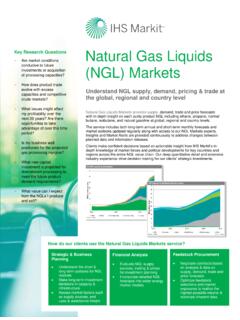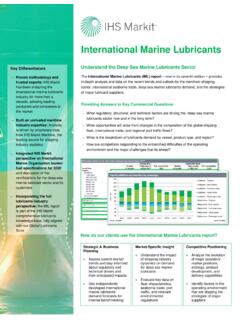Transcription of A practical 10-step guide to collateral management
1 A practical 10-step guide to collateral managementThis whitepaper was originally published by CloudMargin in June 2017 IHS Markit and CloudMargin partner to offer integrated services and technology for a best-in-class solution that covers the full workflow of collateral management , portfolio valuation, and regulatory Risk Operational Risk Liquidity Risk Correlation RiskCounterparty ExposureRisk Exchange Through Use of CollateralIntroduction Traditionally, financial institutions viewed collateral management not as a necessity but as something that had to be performed with little concern, a reactive function positioned at the culmination of the trading cycle that didn t require too much attention or thought.
2 For many years, collateral s risk exchange function has been, conceptually at least, well understood in the financial markets - albeit a process that was not a priority for firms pre-2008. The 2008 financial crisis and the years following have had an unprecedented and drastic impact on the perception of collateral management and the importance of its operations. Unsurprisingly, regulatory changes have come hand in hand with the credit crisis to prevent a similar scenario developing again - mandating the use of collateral for virtually all market participants and penalizing anyone unable to comply.
3 The most recent regulatory change to rock the industry was the March 1 variation margin deadline for uncleared derivatives. From March 1st 2017, almost everyone trading uncleared over-the-counter (OTC) derivatives now has to calculate variation margin, determine if a collateral movement is required and send or receive a collateral payment. What s more, this process is now required every day. This applies to all OTC derivatives and therefore captures those FX non-deliverable forwards (NDFs) that have not traditionally been collateralized.
4 If you also consider that eligible OTC derivatives are now mandated for central clearing, it is a safe estimate that the number of margin calls you will have to calculate and make will increase by approximately 500%.This is just one example of regulatory upheaval within the industry. Other observations include use of trade repositories, Basel III capital charges and a change of internal counterparty credit risk management practices, to name but a , the level of visibility and scrutiny that collateral management is now facing means that firms need to know that the data they are receiving is without doubt correct and that they are indeed covered from any exposure that may occur.
5 By no means last, it is also imperative that firms understand the regulations that are impacting their business and then act appropriately to ensure the proper process is in place to execute those obligations the role of collateral grows in your organization in terms of relevance, time and cost, it is increasingly important to take full control of your collateral management program, irrespective of company size or traded instrument. With this in mind, CloudMargin has produced this white paper outlining the basics of collateral management in a complete, easy-to-digest, practical 10-step guide .
6 This practical guide to collateral management white paper will cover all fundamental aspects concerning the management of collateral , the associated risks and opportunities, as well as the key topics involved in establishing and running a collateral management function. Variation MarginThe mark-to- market value (unrealized profit/loss) of a portfolio. Upon default these securities are used by the solvent entity to avoid immediate lossInitial MarginThe sum of money that could conceivably be lost over a defined period, post a default.
7 The period is defined by regulation and differ by instrument from 1 day to 20 days or more1. What is collateral management ? collateral management is the process of two parties exchanging assets in order to reduce credit risk associated with any unsecured financial transactions between them. Such counterparties include banks, broker-dealers, insurance companies, hedge funds, pension funds, asset managers and large corporations. The fundamental idea of collateral management is very simple: cash, securities or other instruments such as bonds and equities are passed from one counterparty to another as security for a credit two parties trading financial instruments that give rise to future cash flows, such as OTC derivatives, run the risk that one of the parties to the trade may default on a future payment, leaving the non-defaulting party with a financial loss.
8 On any given day, the party required to post collateral to the other is determined by calculating the net present value (NPV) of all future cash flows for each open trade or typically discuss collateral in terms of variation margin (VM) and initial margin (IM). Whilst both are collateral , they serve different two parties negotiate and execute a Credit Support Annex (CSA). This contains the terms and conditions under which collateralization will take place and is an annex to the ISDA (International Swaps and Derivatives Association) Master prices move and new deals are added, the valuation of the trade portfolio will party with the negative MTM on the trade portfolio delivers collateral to the party with the positive collateral position is then adjusted to reflect the new valuation.
9 The process continues unless one of the parties trades subject to the collateral agreement are regularly marked-to- market (MTM). Their net valuation is then on what is agreed, the valuation is repeated at frequent intervals - typically daily under the new is a standard OTC derivative collateral transaction between two ISDA Guidelines produced 1998 Buyside begins trading swaps in earnestF&O Programs principally cash collateralTri-party program s still manualSecond ISDA Guidelines published 2005 Some buyside begin collateralising repoBanks introduce collateral Optimisation GroupsLarge Banks collateralise OTC derivatives and some repoStock loan programs managed by CustodiansEnterprise wide
10 collateral ManagementG20 meets to discuss the response to the Global financial CrisisWhen collateral management was first introduced in the 1980s, operational and treasury departments within various institutions carried out this risk management function unobtrusively in the background. This business function was thrown into the limelight with the shattering financial market crash of 2008. The crisis caused treasury and operational departments to be hauled to the front end of businesses, coming under scrutiny and evaluation like never before.













